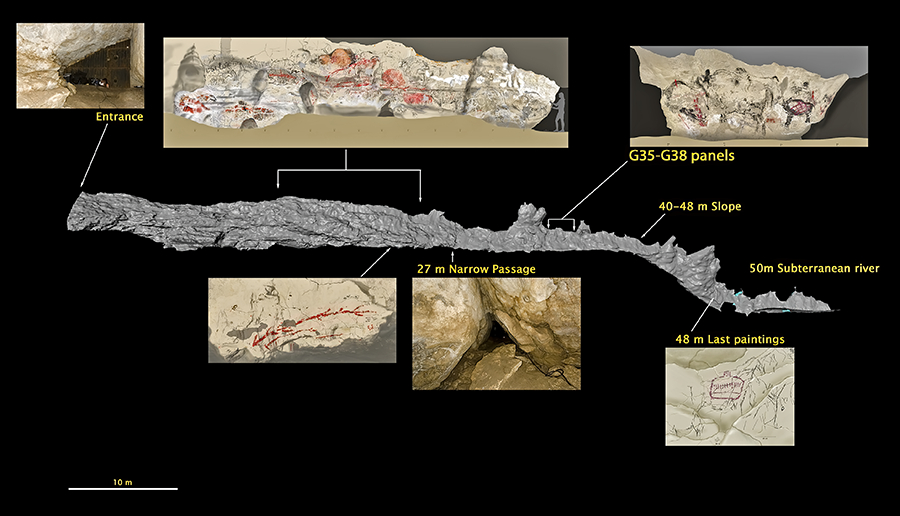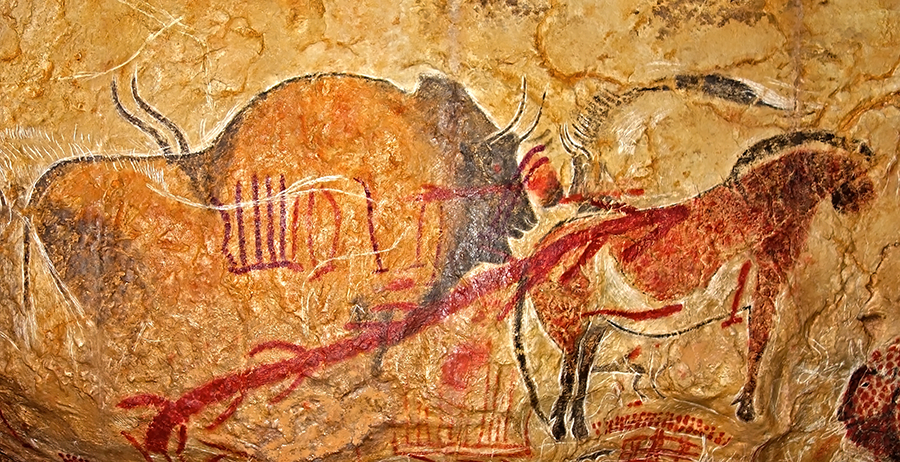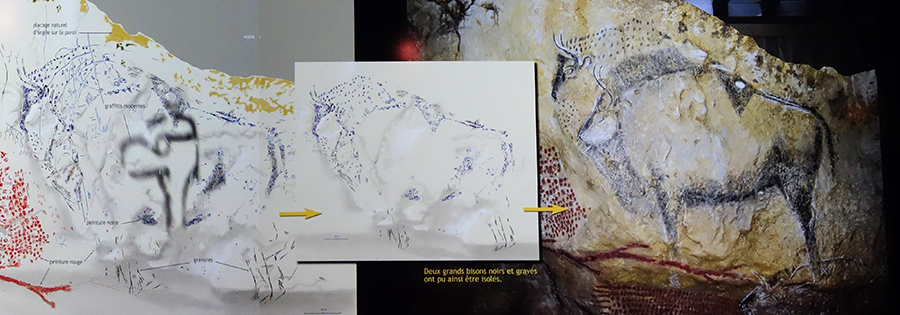Marsoulas - La Grotte de Marsoulas, ice age art
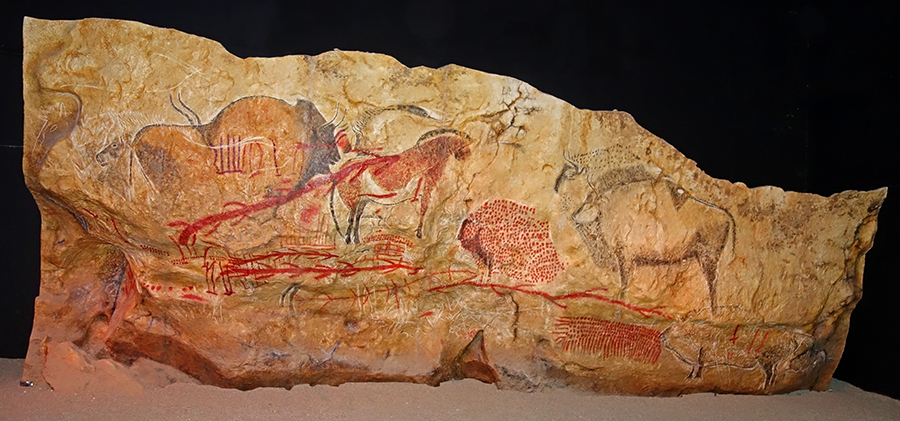
La Grotte de Marsoulas, replica of the Grand Panneau.
Photo: Ralph Frenken 2019
Source: Le Parc de la Préhistoire de Tarascon-sur-Ariège

The Great Panel of the Marsoulas cave (Haute Garonne) is very difficult to access, and has been damaged by modern graffiti. 15 000 years ago, it contained beautiful polychrome paintings and dozens of engraved animals. From 2008 to 2009, the facsimile of this ornate wall was replicated. In the studio of Alain Dalis in Montignac (Dordogne), Gilles Tosello did not just reproduce the images in their current state. He proceeded to a real restitution, restoring all the original brilliance to this emblematic tour de force of Magdalenian art. With his companion Carole Fritz, researcher at the CNRS, he studied in detail this composition in the real cave. The completed facsimile was installed at the Prehistory Park of Tarascon-sur-Ariège.
Photo and text: https://www.passesimple.net/fac-simile-de-marsoulas
Marsoulas - La Grotte de Marsoulas, near Salies (Haute-Garonne), is formed by layers of limestone raised vertically against other layers which then buttress each other. It is the result of a fault. Around 1885, the Abbé Cau-Durban, archaeologist from Ariege, found the floor consisting of carbonaceous ash, animal bones, and worked flint. Patiently he collected many artefacts, the remains of an ice age site. The type of industry and the absence of barbed harpoons led him to believe its relative great age. The cave has since been explored thoroughly, and has revealed paintings and engravings of bison and horses on the walls, as well as artefacts from the ice age, and a huge Triton bailer shell from the sea 300 km away.
Text above translated and adapted from: Cartailhac (1902)
Marsoulas cave. Complete 3D profile of the cave from the entrance to the end. The panels G35–G38 are presented as examples of the methodological protocol.
(doc. G.Tosello/C·Fritz).
Photo and text: Fritz et al. (2016)
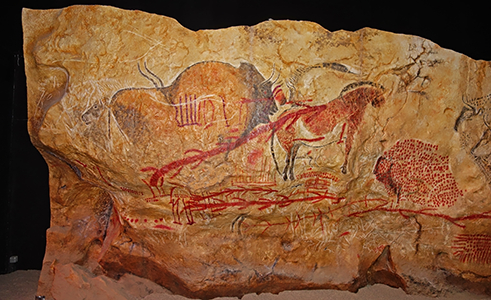
The complex left hand side of the Grand Panel displays a number of important features, including polychrome representations of the bison and horse, a bison made up mostly of red dots, with dark shading to delineate the face and forequarters of the bison, engravings and monochrome representations of horses, isolated lines of large red dots, enigmatic signs, a quasi-rectangular red tectiform, and a series of lines and arrows that might represent vegetable forms, or be meant to represent something quite different.
Photo: Ralph Frenken 2019
Text: Don Hitchcock
Source: Le Parc de la Préhistoire de Tarascon-sur-Ariège
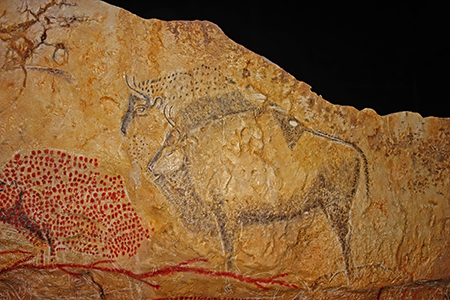
The right hand side of the Grand Panel is dominated by two bison, which have been completed using both painting and etching. The foremost bison is exquisitely detailed, while the bison at the rear has had a great deal of attention given to the head and horns, while the body is indicated by black dots only.
This dot effect was also used for the iconic bison on the left, where red dots were used for most of the figure. An alternately organised vegetable shape dominates the bottom of this part of the panel, with another bison, red dots and lines, and etched animals out of frame in this image.
Photo: Ralph Frenken 2019
Text: Don Hitchcock
Source: Le Parc de la Préhistoire de Tarascon-sur-Ariège
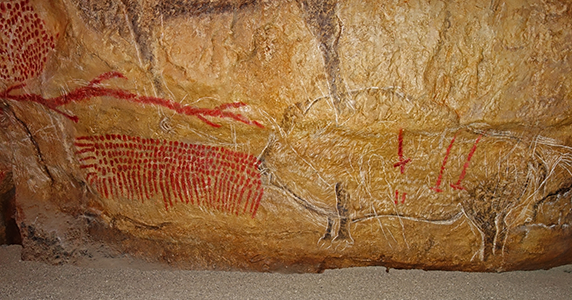
This lower right section displays red dots and lines, a red plant-like figure, with alternate branches, and a well realised portrait of a bison in black, with the piece given extra dimension by scratching through the patina on the rock, by a master artist.
Photo: Ralph Frenken 2019
Text: Don Hitchcock
Source: Le Parc de la Préhistoire de Tarascon-sur-Ariège
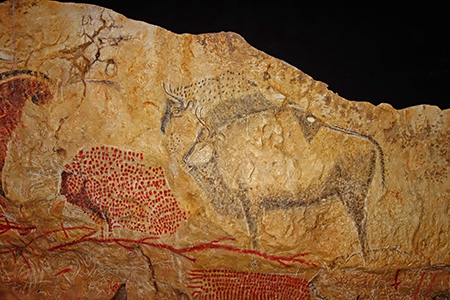
This image is focused on the 'red dotted' bison, an iconic image of Marsoulas. It has been given life by the addition of a well constructed eye (which was not an addition by the restorer, since it appears on the original artwork), and engraving into the patina of the rock surface. The hindquarters are only suggested, in marked contrast to the larger, darker bison above it. The 'red dotted' bison may well have had some ritualistic importance.
Photo: Ralph Frenken 2019
Text: Don Hitchcock
Source: Le Parc de la Préhistoire de Tarascon-sur-Ariège

This is a very complex part of the panel, and repays careful study of the full size version, obtained as always by clicking on the small thumbnail shown here.
There are many animals, including a large engraved reindeer with the back legs painted in a dark colour, two bison engraved in the surface patina of the rock, what appears to be a small engraved aurochs but without horns, but with the head coloured in, an engraved fox head, as well as a red tectiform, together with painted lines with leaf-like off shoots, one of which is more like a symbol only, since the cross lines are straight, with some at an angle, and some at ninety degrees to the line.
Photo: Ralph Frenken 2019
Text: Don Hitchcock
Source: Le Parc de la Préhistoire de Tarascon-sur-Ariège
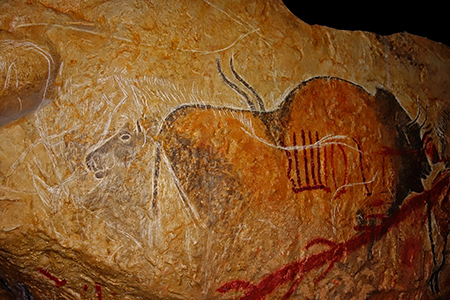
Two engraved horse heads can be made out in this section of the panel, with three stiff manes. One of the horse heads has been infilled with a dark colour.
Photo: Ralph Frenken 2019
Text: Don Hitchcock
Source: Le Parc de la Préhistoire de Tarascon-sur-Ariège
The large polychrome bison has its tail and dorsal line outlined in black, with the head and neck completed in brown and black. It is overlain by various linear symbols in red, as well as the ubiquitous thick red meandering line which is so much a feature of this panel, with paired red 'leaves' in this instance at regular intervals.
To the left, and behind, is the dorsal line, head, horns, and mane of another bison, completed in black.
On the right in this image is a horse in red, brown and black, and shown with what is apparently meant to be a white abdomen. It is also overlain by red symbols.
Photo: Ralph Frenken 2019
Text: Don Hitchcock
Source: Le Parc de la Préhistoire de Tarascon-sur-Ariège
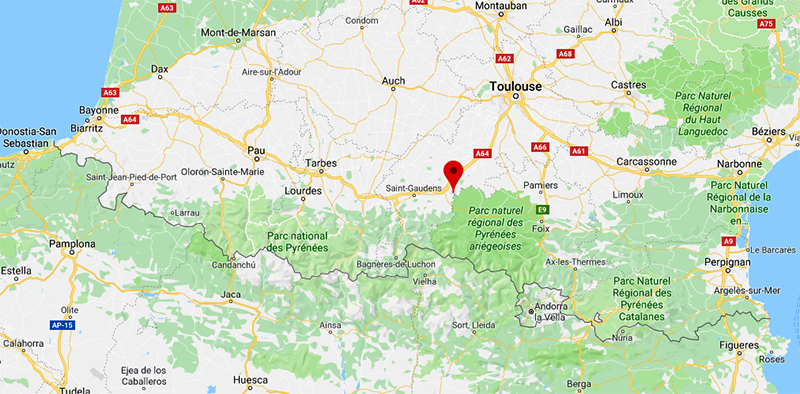
Marsoulas is in the south of France, near the Parc naturel régional des Pyrénées ariégeoises
Photo: Google Maps
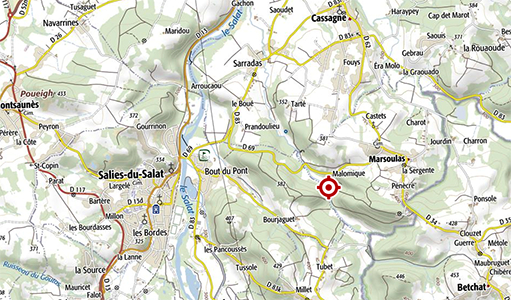
Location of Marsoulas.
Photo: https://www.france-voyage.com/cities-towns/marsoulas-10329/cave-marsoulas-20320.htm
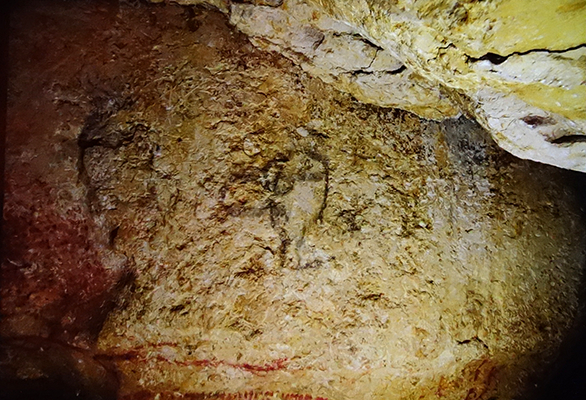
This shows the huge problems faced by those curators and artists who wish to recreate the former glory of the paintings. The painting has been defaced with graffiti and time, and is barely visible as seen in this photograph of the original within the cave itself.
Photo: Le Parc de la Préhistoire de Tarascon-sur-Ariège
Rephotography: Ralph Frenken 2019
Text: Don Hitchcock
By careful and rigorous examination of the large scale photographs, the restorers are able to first tease out the original form of the paintings, and then with great skill and attention to detail and wonderful technique, the paintings can be restored.
Photo: Le Parc de la Préhistoire de Tarascon-sur-Ariège
Rephotography: Ralph Frenken 2019
Text: Don Hitchcock
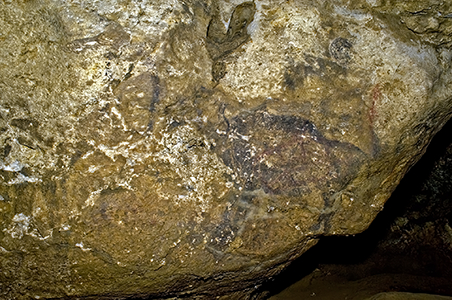
Panel of paintings and engravings on the left wall, between 37 and 38 m from the
entrance. In addition to the black bison on the right, once can discern vestiges of red
pigment belonging to geometric signs.
Photo and text: image C. Fritz, Fritz et al. (2016)
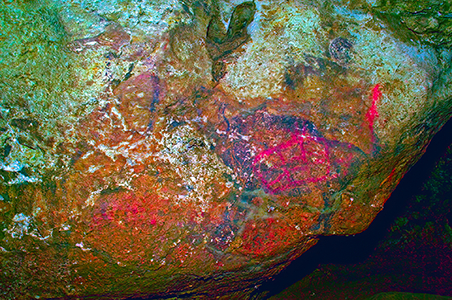
DStretch treatment (a false colour technique) of the preceding photo renders visible an additional red tectiform sign on the body of the black bison. This type of sign is very rare in the region of the Pyrenees.
Photo and text: image C. Fritz, Fritz et al. (2016)
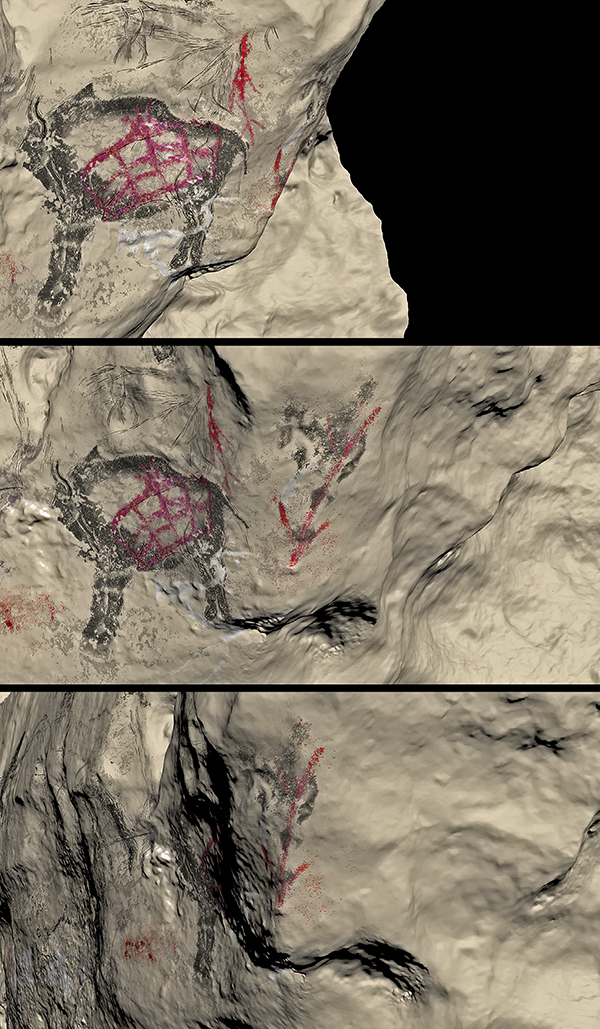
The red tectiform sign on the bison above has been made visible in this drawing, and these renderings show how the edge of a protrusion on the cavewall was used for the profile of an animal face and a red vertical sign.
( note that these rectangular tectiform signs are common in Spanish painted caves - Don )
Photo and text: image Fritz/Willis/Tosello, Fritz et al. (2016)
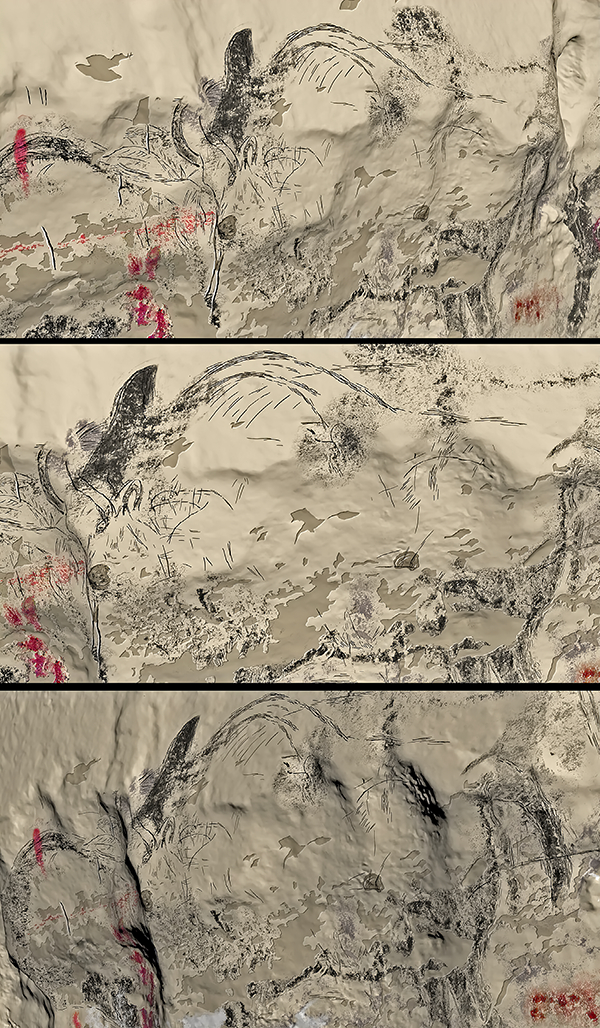
Three renderings of the same bison from different angles. Note that the natural form of the rock surface that forms the bison's brow is more visible in the bottom image, due to a specific configuration of the lighting (image Fritz/Willis/Tosello).
Photo and text: image Fritz/Willis/Tosello, Fritz et al. (2016)
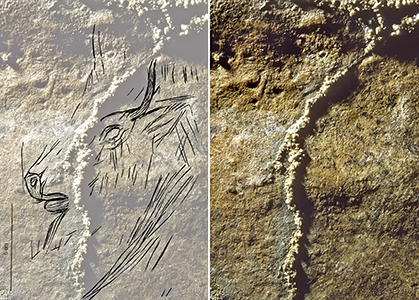
One of the primary difficulties of interpretation stems from the abundance of surfaces covered with fine, overlapping engravings like the miniature bison head shown here.
Photo and text: C. Fritz et G. Tosello, Fritz et al. (2016)
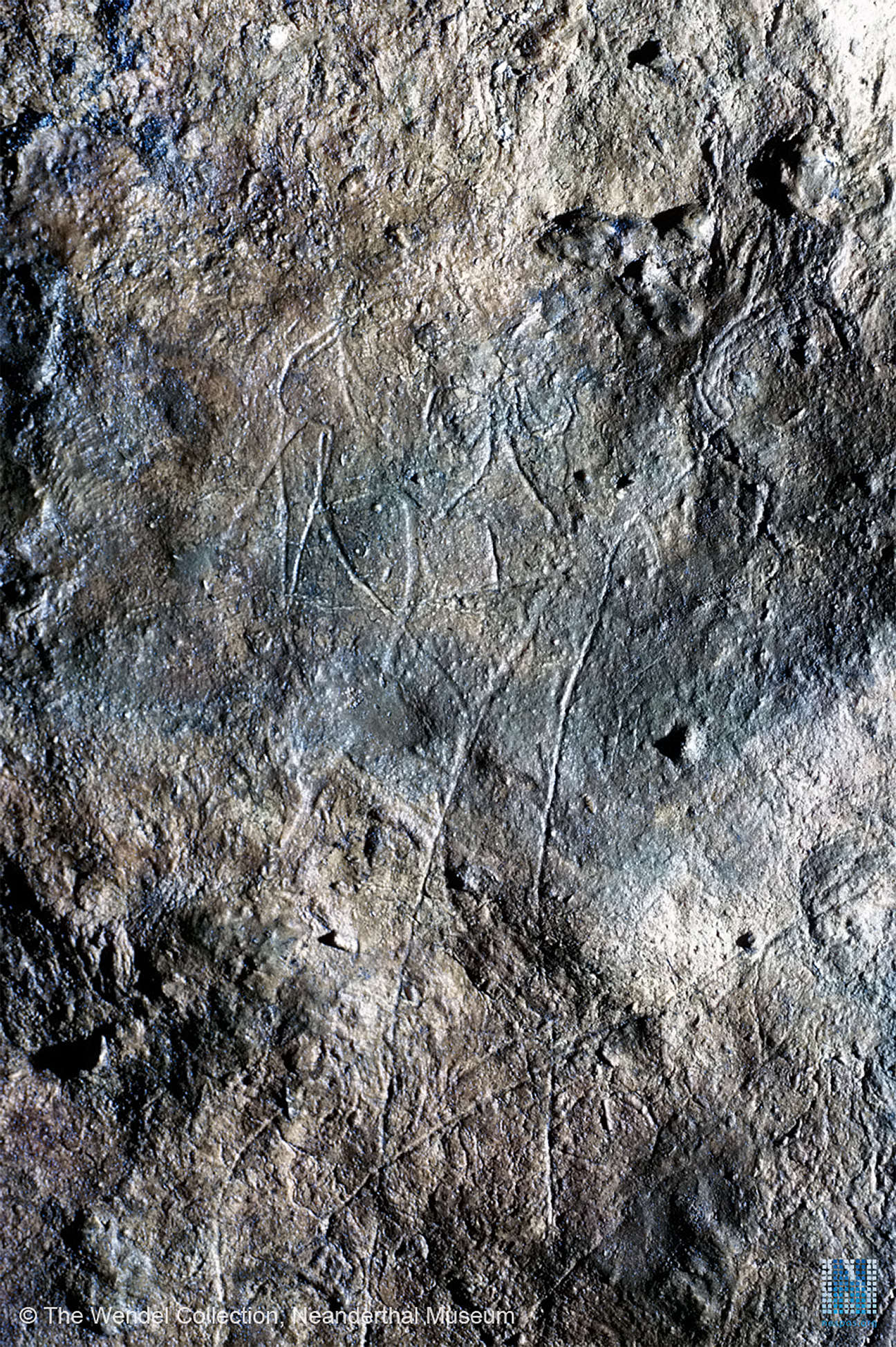
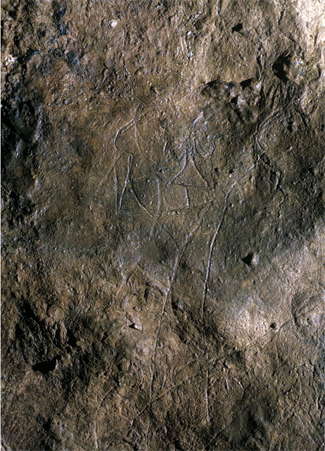
Anthropomorphic engraving at Marsoulas.
Original engraving on the wall.
(left)
Marsoulas Galerie ornée : Photo Heinrich Wendel (© The Wendel Collection, Neanderthal Museum)
Photo: Wendel Collection: Marsoulas
Source: Donation
Copyright Holder(s): © [PublicAdministrativeSpace: Neanderthal Museum]
Website: https://www.nespos.org/pages/viewpage.action?pageId=50168397
(right)
Engraving of the front view of a human head, 40 metres from the entrance. The image is abstract: round eyes, broad nose and triangular, split lip.
Photo: © C. Fritz
Source: http://www.creap.fr/Marsoulas.htm
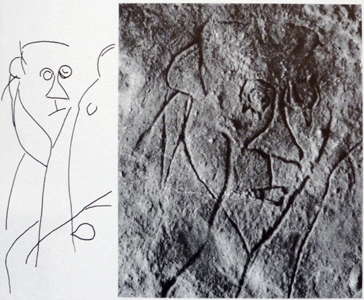
Anthropomorphic engraving, Marsoulas, the same as the one in the images above.
Photo: Leroi-Gourhan (1973)
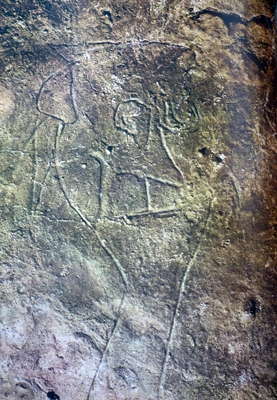
In this version of the image, we can see what appears to be a long neck, not obvious in the other photos.
Photo: Leroi-Gourhan (1973)
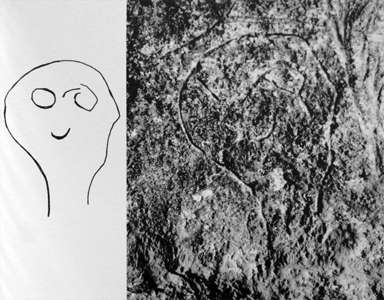
A second anthropomorphic engraving, Marsoulas. Frontal view of a face.
Photo: Leroi-Gourhan (1973)
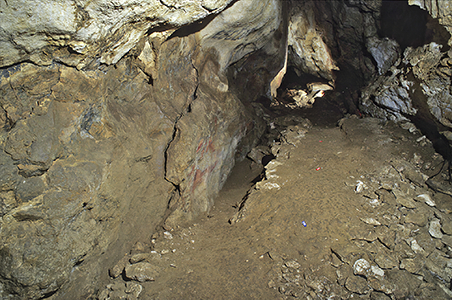
From the entrance to the back of the cave, the gallery is straight in plan and triangular in section. The trench from early excavations is visible at left.
Photo and text: image C. Fritz, Fritz et al. (2016)
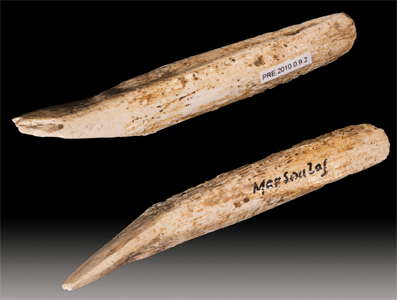
Tip of spear, original, Marsoulas.
The spear point is of the type known as 'Lussac-Angles'
Date: between 15 000 BP and 12 000 BP, Middle Magdalenian (III and IV)
Dimensions: 52 mm× 11 mm × 7mm - 1.9g
Material: Reindeer antler
Location: Muséum de Toulouse, MHNT.PRE.2010.0.9.2
From the excavations by Félix Régnault.
Photo: Didier Descouens , April 8, 2011
Date: 08.04.2011
Permission: Creative Commons Attribution - Share Alike 3.0

Popular Science May 1892
Vol. 41, No. 1 - 150 pages - Magazine
The cave of Marsoulas, in the Haute-Garonne, France, was inhabited by man several times during the palaeolithic age. The relics of what is designated as the second occupation are interesting on account of the specimens of artistic taste they afford. Besides the usual instruments of silex, arrow-points, and the like, were found some peroxide of manganese, which was probably used in tattooing, and engraved designs ; a piece of bone adorned with a regular ornamentation, engravings very much like those found in the valley of La Vézere ; and a piece of rib having an ovibos (or musk ox) carved upon it, in which, according to the Marquis de Nadaillac, the design is treated with exact knowledge of anatomical forms, the relief is brought out by shadings, and the drawing is vigorous.

Prehistoric pendant, on a reindeer antler. Excavations from Cau-Durban in 1883.
Age : Magdalenian, 17 000 BP - 10 000 BP
Locality : Marsoulas cave, Marsoulas, Haute-Garonne France.
Catalog: Muséum of Toulouse MHNT.PRE.2009.0.249.1
Photo: Didier Descouens
Permission: Creative Commons Attribution-Share Alike 4.0 International license. It is not permitted to upload this file to Facebook.
Text: Wikipedia
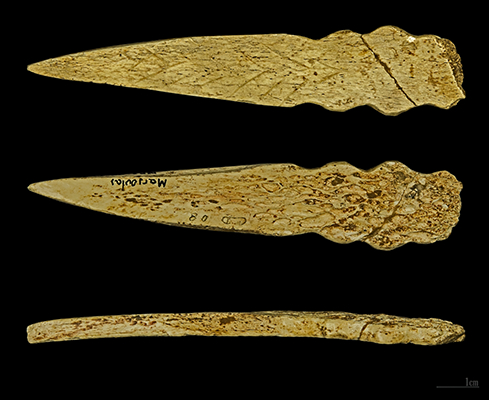
Decorated piece of reindeer bone. Initial excavations Cau-Durban in 1883.
Age : Magdalenian 17 000 BP - 10 000 BP
Locality : Marsoulas cave, Marsoulas, Haute-Garonne France.
Catalog: Muséum of Toulouse MHNT.PRE.2009.0.249.1
Photo: Didier Descouens
Permission: Creative Commons Attribution-Share Alike 3.0 Unported license. It is not permitted to upload this file to Facebook.
Text: Wikipedia
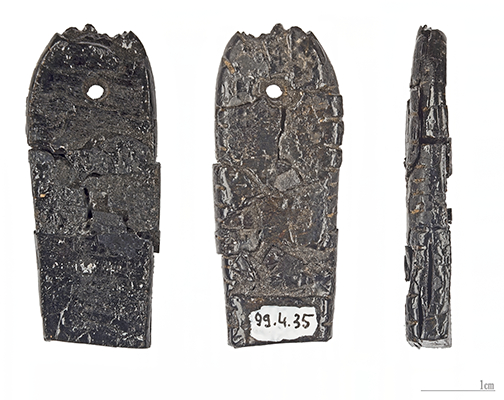
Prehistoric pendant, in lignite. Three views of the same object.
Age : Magdalenian 17 000 BP - 10 000 BP
Locality : Marsoulas cave, Marsoulas, Haute-Garonne France.
Catalog: Muséum of Toulouse MHNT.PRE.2012.0.6.95
Photo: Didier Descouens
Permission: Creative Commons Attribution-Share Alike 4.0 International license
Text: Wikipedia
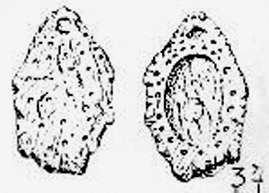
At Marsoulas, there is a carved turtle pendant on a small oval with a carved hole for a string. It is unique because it was the first time that this animal was reported in prehistoric art.
This is one of many objects found during excavations by Abbé Cau-Durban from 1883. However many successive excavations have helped to disperse these objects into various private collections and several museums.
They are usually fragments of animal bones such as rib fragments engraved with a buffalo, pierced teeth, and so on.
Photo, and text adapted and translated from:
http://membres.lycos.fr/jeff31/tortue.jpg

Plan of the decorated part of the Marsoulas cave.
Photo: Wendel Collection: Marsoulas
Source: Donation
Copyright Holder(s): © [PublicAdministrativeSpace: Neanderthal Museum]
Website: https://www.nespos.org/display/PublicNesposSpace/Marsoulas+-+Wendel+collection
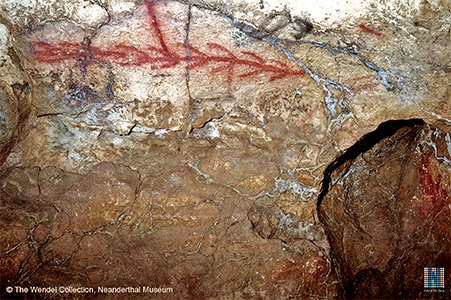
Painting in red of a series of chevrons connected by a line.
Original painting on the wall of Marsoulas.
Marsoulas Galerie ornée : Photo Heinrich Wendel (© The Wendel Collection, Neanderthal Museum)
Photo: Wendel Collection: Marsoulas
Source: Donation
Copyright Holder(s): © [PublicAdministrativeSpace: Neanderthal Museum]
Website: https://www.nespos.org/pages/viewpage.action?pageId=50168397
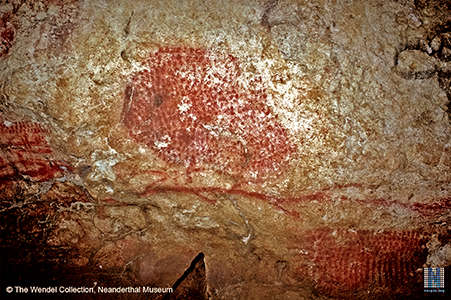
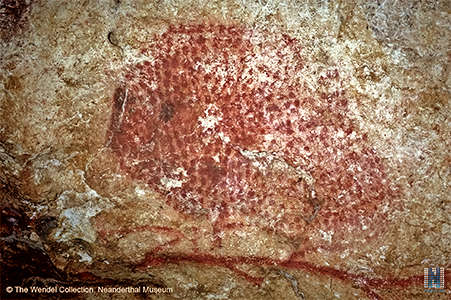
Painting of a bison composed of red ochre dots. Note the red line below it, with branching lines alternately positioned.
Original painting on the wall of Marsoulas.
Marsoulas Galerie ornée : Photo Heinrich Wendel (© The Wendel Collection, Neanderthal Museum)
Photo: Wendel Collection: Marsoulas
Source: Donation
Copyright Holder(s): © [PublicAdministrativeSpace: Neanderthal Museum]
Website: https://www.nespos.org/pages/viewpage.action?pageId=50168397
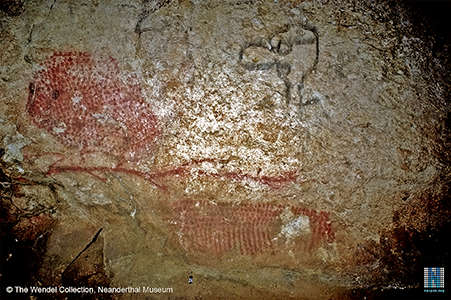
Red bison, line with alternate branches, and an enigmatic sign below of dots and lines.
Modern graffiti in black on the upper right of the image, possibly made using candle soot on the ceiling.
Original painting on the wall of Marsoulas.
Marsoulas Galerie ornée : Photo Heinrich Wendel (© The Wendel Collection, Neanderthal Museum)
Photo: Wendel Collection: Marsoulas
Source: Donation
Copyright Holder(s): © [PublicAdministrativeSpace: Neanderthal Museum]
Website: https://www.nespos.org/pages/viewpage.action?pageId=50168397
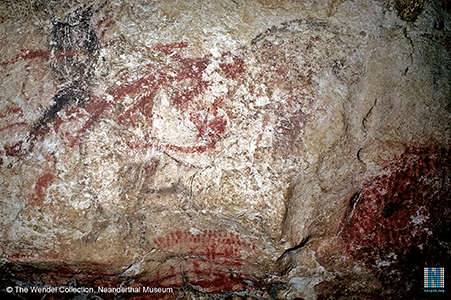
Horse painted in red and black. The mane, head, tail and legs are in black, with most of the body in red.
Original painting on the wall of Marsoulas.
Marsoulas Galerie ornée : Photo Heinrich Wendel (© The Wendel Collection, Neanderthal Museum)
Photo: Wendel Collection: Marsoulas
Source: Donation
Copyright Holder(s): © [PublicAdministrativeSpace: Neanderthal Museum]
Website: https://www.nespos.org/pages/viewpage.action?pageId=50168397

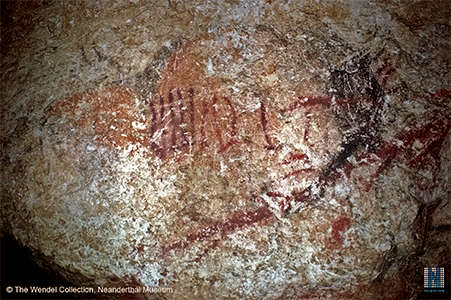
Thick red line in the middle of the image on the left, with two red lines below, and the rear of the horse showing on the right.
Other red lines in a pattern of uncertain meaning may be seen clearly in the right hand image, inside the dull orange image of a bison.
Original painting on the wall of Marsoulas.
Marsoulas Galerie ornée : Photo Heinrich Wendel (© The Wendel Collection, Neanderthal Museum)
Photo: Wendel Collection: Marsoulas
Source: Donation
Copyright Holder(s): © [PublicAdministrativeSpace: Neanderthal Museum]
Website: https://www.nespos.org/pages/viewpage.action?pageId=50168397
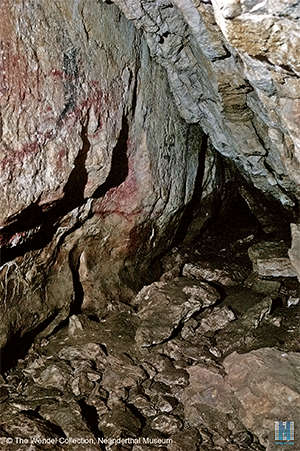
Photo showing the vault of the gallery, with two bedding planes of limestone meeting in a V at the top.
Marsoulas Galerie ornée : Photo Heinrich Wendel (© The Wendel Collection, Neanderthal Museum)
Photo: Wendel Collection: Marsoulas
Source: Donation
Copyright Holder(s): © [PublicAdministrativeSpace: Neanderthal Museum]
Website: https://www.nespos.org/pages/viewpage.action?pageId=50168397
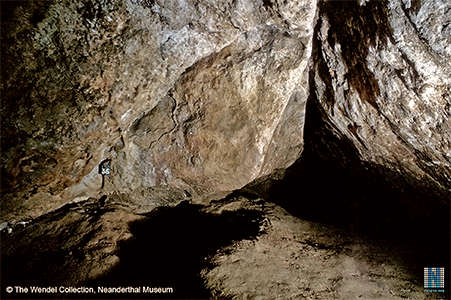
Another photograph of the vault of the gallery.
Marsoulas Galerie ornée : Photo Heinrich Wendel (© The Wendel Collection, Neanderthal Museum)
Photo: Wendel Collection: Marsoulas
Source: Donation
Copyright Holder(s): © [PublicAdministrativeSpace: Neanderthal Museum]
Website: https://www.nespos.org/pages/viewpage.action?pageId=50168397

Entry to marsoulas cave.
Photo and text: http://archeologie.culture.fr/lascaux/en/mediatheque/entry-marsoulas-cave-midi-pyrenees
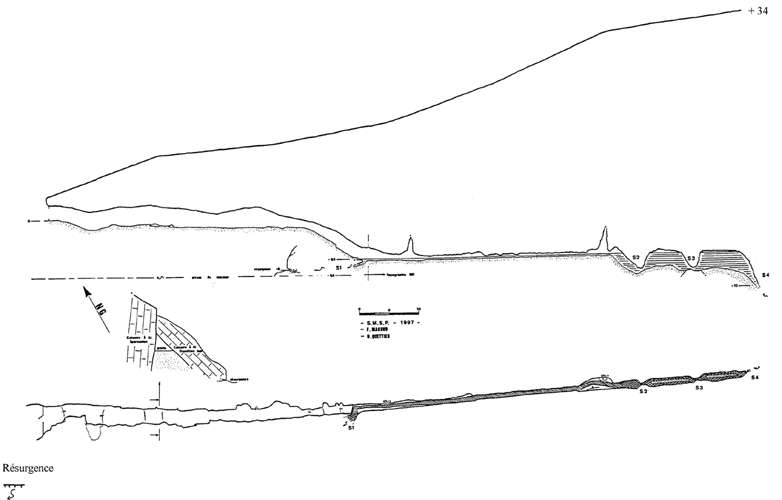
Marsoulas, plan of the cave.
The cave is in an Upper Thanetian limestone.
Explorations :
- Abbé Cau Durban, 1883 - 1884.
- F Regnault, L Jaummes, discovery of engravings, 20.04.1897.
- Rivière, F Regnault, Cau Durban, 06.05.1898.
- F Regnault, L Jaummes, E Castailhac, 04.08.1902.
- E Castailhac, Abbé Breuil, 18.08.1902.
- E Castailhac, Abbé Breuil, 1905.
- R Jeannel, 12.08.1907.
- Comte Bégouën et Rusell, 1931.
- SMSP - F Maksud, D Quettier, F Bréhier, full topography of the cavity and the two successive siphons 25.08.1997.
Closed entrance, preceded by a short canyon formed by the collapse of the vault.
Gallery 4 m wide, 30 m from the constriction at the entrance, level ground.
Sloping ground for ten metres.
Stream in the very narrow gallery, 43 m long.
Siphon 22 m long (2 bells) descending to - 6 m, heavy clay.
The source is located 1 m above the Laouin and 10 m below the cave.
Could drain the valley of Spades Porte, ESE of the cave.
Photo and text: http://cds31.free.fr/Htm/Grottes/marsoulas.htm
Note sur les dessins préhistoriques de la grotte de Marsoulas
La Grotte de Marsoulas, near Salies (Haute-Garonne), is formed by layers of limestone raised vertically against other layers which then buttress each other. It is the result a fault. Around 1885, the Abbé Cau-Durban, archaeologist from Ariege, found the floor consisting of carbonaceous ash, animal bones, and worked flint. Patiently he collected many artefacts, the remains of an ice age site. The type of industry and the absence of barbed harpoons led him to believe its relative great age. The research was discontinued, at the time when they came to the best chambers, because of the danger presented by the sloping roof, completely fractured over a length of five metres and whose blocks detached and fell from the roof from time to time.
Abbé Cau-Durban had seen a few lines painted in red ochre on the left hand cave wall. He had neglected to examine them, assuming them to be very modern. The cave has been known and visited for a long time, and on the wall surfaces visitors had engraved names, dates, and other graffiti. A few years later, Mr. Félix Regnault, of Toulouse, the Paris Museum which has some fine palaeontological specimens , had the occasion to visit Marsoulas with M. Jammes, leader of the work of zoology at the University of Toulouse, and as they heard of the discoveries by M. Rivière in the cave of la Mouthe at Les Eyzies (Dordogne), and Mr. Daleau in the cave Pair-non-Pair, at Marcamps (Gironde), they examined the red lines and saw that they were a set of signs. There were at the top two or three animal silhouettes in black and red. At the invitation of Mr. Regnault, M. Rivière came to Marsoulas, noted the reality of the observations without any conclusion and without adding anything.
I could not join them, and it was not until much later, 2nd August 1902, I went to the cave. Meanwhile, developments of importance had occurred. MM. Dr. Capitan and Abbé Breuil had observed, and published in part, the innumerable engravings and cave paintings at Combarelles and Font de Gaume, in Les Eyzies. M. Rivière, by clearing the galleries of accumulated deposits, had greatly increased the number of engravings at la Mouthe, and finally, a discovery made some time ago, misunderstood at the time and overlooked quite wrongly, was that of the cave paintings of Altamira, near Santander, in Spain, by M. de Sautuola, was recalled to our memories.
Thus informed, I had no difficulty in recognising that the Marsoulas frescoes fell into this same category of works of art. I could show my companions, MM. Regnault and Jammes, line drawings that enhanced, corrected or complemented the contours, the use of halftones and darker shades or even black to make the modelling, or make some parts more prominent. I discovered, in addition, other painted figures and especially a quantity of shallow engravings without any colour, often delineating oxen, and sometimes horses. I noted, finally, characters of authenticity and antiquity of all the works, including superimposed stalagmite concretions.
The following week, the Congress of the French Association for the Advancement of Science was sitting at Montauban. Regnault and I announced these facts, and two of our colleagues, MM. Chauvet and Daleau, came at our invitation, and together we toured the caves, as well as MM. Rivière and Breuil. Finally, at my invitation, M. l'abbé Breuil joined me in the careful study and survey of the various drawings at Marsoulas. We should publish them in l'Anthropologie, but I am pleased to submit them here before the Academy, to be the first to be informed.
The entry to the grotte de Marsoulas, at first reasonably high and wide, soon, after twenty metres, is reduced to a narrow triangular corridor where one must walk on one's knees. The ground is level for forty metres; then you must crawl down a slope, and arrive at a stream and unexplored galleries, the ground being formed of soft and deep clay.
Engravings and paintings began as soon as we crossed the threshold, but here they are most frequently damaged, adversely affected by modern engravings and inscriptions. Soon they emerge from these deplorable additions, and they can then be observed unsullied, not only on elevated surfaces above the level that the hands of visitors can reach, but also lower down in the corridors that they have fortunately been unable to get to easily. In the descent to the stream, the engravings are more distinct than anywhere else. The paintings do not extend to this point.
Everywhere we could see that one or other of the designs descended below the present ground level. For some of the artworks we have identified, we are concerned that the movement of silt or animals has worn the rock and erased the lightest engravings. Careful excavations will permit us to know to what archeological level the figures penetrate.
If the cave began at the current threshold (a portion is perhaps collapsed), and if the entrance was the same as it was during the ice ages, daylight, especially at sunset, lit the first part of the main panel of paintings. Beyond that, however, it was necessary to use artificial light to make these drawings, which are more skillful and more interesting than those depicted on copies, as they embrace all the contours of the wall, and often take advantage of accidents of the rock contours. We see them disappearing, continuing into depressions where our eye is unable to get in front of them and see all of the animal, yet they are represented exactly.
No doubt the prehistoric artists did not draw their pictures in the difficult situations that we see now, but they did leave engravings on the ceilings, and we can presume the existence of floors, when we consider how the figures are aligned, and the work was never done in a lazy afternoon. However, we still need to explain this fact, which caused the first skepticism about the ceiling frescoes of Altamira: the absence of any stain of black smoke on rocks that have so well preserved the fragile traces of red or black pigments and the slightest scratch.
The engravings, whatever their size (and there are some whose heads are reduced to two or three centimetres, while others although rare, are almost half natural size), are treated like those other ornamental objects of bone and ivory which we have, and are the legacy of our most interesting reindeer or ice age. We have many bison and cattle depicted, some horses, probably an ibex , maybe a deer. No reindeer, no mammoth. The paintings are unique in that they emphasised such different, exaggerated characteristics resulting in strange patterns: those of Altamira were disconcerting.
There is the same impression, though attenuated, in Font de Gaume and Marsoulas. On the other hand, given the rigour of the life of hunters of that time, their wish to reproduce nature exactly, we can probably learn from these paintings some information for the benefit of the description of these former species.
We have to study if there is not an intentional choice in the species represented: why, for example, there are so many bison and cattle, and so few other animals. Below the level of the Marsoulas paintings, there is a considerable body of signs that M. Regnautt has reported and that we have carefully noted. Although one of these signs - the principal one - is placed in the middle of a bison, and was painted later than the bison, I firmly believe they are all from the same era as the painted figures of animals. But it is certain that these signs overlap in many places the lines of the images. Secondly, I have not seen any of the signs of that kind simply engraved. It is also possible that the engravings were completed as a group, even prior to all the paintings. This needs to be checked with others.
M. l'abbé Breuil, during our investigations, could not help noticing the similarity of those signs with some coloured pebbles from the Mas-d'Azil. Have our paintings come from the late Paleolithic period, when at that time when we see such a wide use of the colour red such as that with which the human skeletons themselves were covered? In this approximation one can object that the aurochs appears to have had its maximum abundance long before that, and in the Dordogne, the painted aurochs and the engraved mammoths are contemporaries. Does a difference in latitude imply a difference of wildlife?
Marsoulas has a number of these signs, well spread out. One might assume that they are ornamental fantasies. It is not permissible to allege, however, that they are the result of an individual whim, since, in some details our signs connectin one sense to the series at Font de Gaume, and on the other to the series at Altamira, poorly studied elsewhere. Did they have a sense known to insiders, an intentional value?
Many questions are raised by our findings. We already have seven caves, perhaps eight, with engravings or paintings of this kind, and each has its special features. Overall, this is an ethnographic fact of utmost significance.
Text above translated and adapted by Don Hitchcock from: Cartailhac (1902)
La Campagne de Fouilles de 1931 à Marsoulas, Tarté et Roquecourbère
Translated and summarised by Don Hitchcock
…After receiving the permission of Fine Arts, the cave being classified as a historic monument, it was decided, by mutual agreement, we would start in July on excavations of the terrace in front of the cave. It was necessary to clear away a large mass of earth and stones, which allowed us also to make some interesting observations about the changes that the ground had suffered since Quaternary times.
Note first that the original entrance of the cave was located several metres in front of the current one, or at least the entrance was preceded by a kind of rock canopy, forming a rock shelter or abri whose ceiling collapsed, which is something that we see in many archaeological sites. There was a layer of more than two metres, near the present entrance, under a layer of topsoil not exceeding one metre. Below is a clay layer, resting on rock, which leads through cracks to the existing creek bed underground, which we meet at the bottom of the cave.
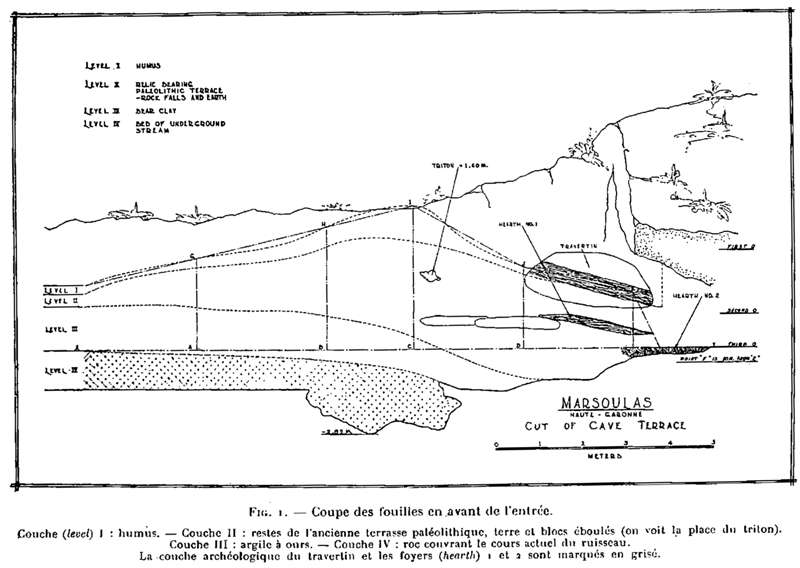
Coupe des fouilles en avant de l'entrée.
Couche (level) I: humus.
Couche II: restes de l'ancienne terrasse paléolithique, terre et blocs éboulés (on voit la place du triton).
Couche III: argile à ours.
Couche IV: roc couvrant le cours actuel du ruisseau.
La couche archéologique du travertin et les foyers (hearth) 1 et 2 sont marqués en grisé.
Cut of the excavation in front of the entrance.
Layer (level) I: humus.
Layer II: remains of the ancient Palaeolithic terrace, earth and fallen rocks (we can see the position of the triton shell which was found here).
Layer III: clay
Layer IV: rock covering the current course of the stream.
The archaeological layer of travertine and hearths 1 and 2 are marked in grey.
Text and photo: Bégouën et al. (1933)
Along the wall of the fault that caused the excavation of the cave, and partially covered by layers I and II, is a deposit of white travertine and spongy, from a lateral runoff of water charged with lime. It consists of three layers, the lower, therefore the oldest, is compact and sterile, the second, greyish, includes coal, flint and back pieces, which appear to have been rolled. The flints are very rare, very cacholonés (having a white patina that obscures the opalescence of flint over millenia - Don ) and decomposed to the point of sometimes not being distinguishable from the travertine. The upper part is sterile and friable.
There were in this layer II two small hearths. The first gave hardly anything, except a few flints, The second, located near the present entrance of the cave and measuring 30 by 60 cm, was strongly impregnated with red ochre. We found few items there, but we picked up throughout the undisturbed layer some bone and flint of the Aurignacian type, enough to recognise that the deposits were Palaeolithic.
As for the lithic industry, there is a beautiful heavily retouched rock crystal scraper (grattoir), which was sent to the Museum of Toulouse join other pieces of rock crystal obtained previously by M. l'abbé Cau-Durban. But although fragments of amorphous hyaline quartz (quartz with a bluish opalescent cast due to the presence of chalcedony - Don ) are sometimes found in prehistoric sites, tools of rock crystal are quite a clear exception, except in the Solutrean.
With regard to the bone industry, we collected some fragments of spears, sometimes slightly ornamented; a kind of scraper made from a piece of bivalve shell, Capulus ungaricus, severely worn, with a hole for suspension, and having its edge internally decorated with incisions.
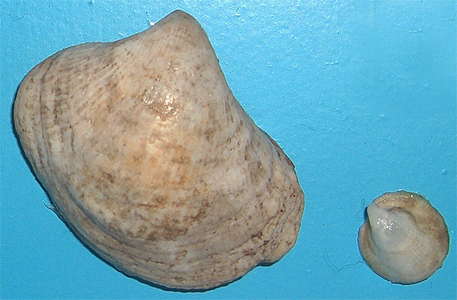
(The common name of Capulus ungaricus is the bonnet shell. It is a species of small sea snail, a marine gastropod mollusk in the family Capulidae, the cap snails. The reason for the name is most clearly seen in the small example shown on the right - Don)
Photo: Georges Jansoone (JoJan)
Date: 28 January 2011
Permission: Creative Commons Attribution 3.0 Unported license
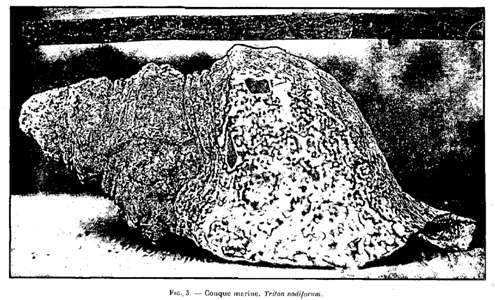
But the most remarkable piece is a huge Triton nodiforum shell, found in the middle of layer II. It is intact, except for a hole caused by an unfortunate blow from a pickaxe, and rather fossilised, but the nacre inside is still slightly pink. It is known that this species inhabits temperate seas, is not present in the ocean beyond the Charente, and is rare in the Mediterranean.
It lives in depths from 25 to 75 metres, and is uncommon on sandy shores. Its average size is about 25 cm, rarely reaching 30 cm, with a width of 17 cm. But the Marsoulas example measures 31 cm. by 18 cm., so it is of an exceptional size. It had remained exposed for a long time on the shore, as its shell was strongly attacked by Clione snails, or 'Sea Angels'. The top had been broken during its lifetime and had healed. The edge of the shell was broken over a width of 2 to 3 cm., widening towards the base. It has, moreover, very clear indications of wear suggesting that the shell was heavily used, perhaps for drinking.
Text and photo: Bégouën et al. (1933)
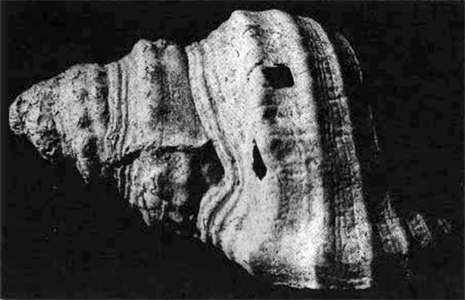
The presence of marine shells in this deposit in the centre of the Pyrenees, 250 to 300 km from the nearest sea, is not at all surprising. All Pyrenean deposits give scallop, conch or cowrie shells, but this is the first time we have encountered a shell of this size, and one wonders exactly how this remarkable piece was used.
This species is now called Charonia lampas
Text: Bégouën et al. (1933)
Photo (also of the specimen from Marsoulas): http://membres.multimania.fr/jeff31/grotte58.jpg
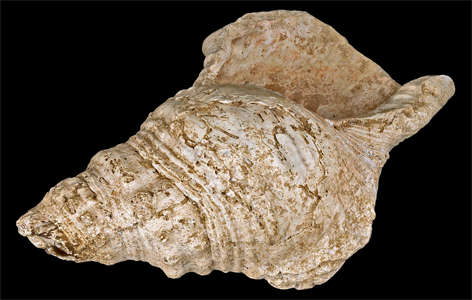
Conch (instrument)
Magdalenian
Locality : Marsoulas cave, Marsoulas, Haute-Garonne France.
Searches in 1931 by Henri Bégouën (University of Toulouse), and J. Townsend Russell (Smithsonian Institution).
Muséum of Toulouse MHNT.PRE.2010.0.1.2
Size: 31 x 18 x 18 cm
Photo: Didier Descouens
Permission: Creative Commons Attribution-Share Alike 3.0 Unported license. It is not permitted to upload this file to Facebook.
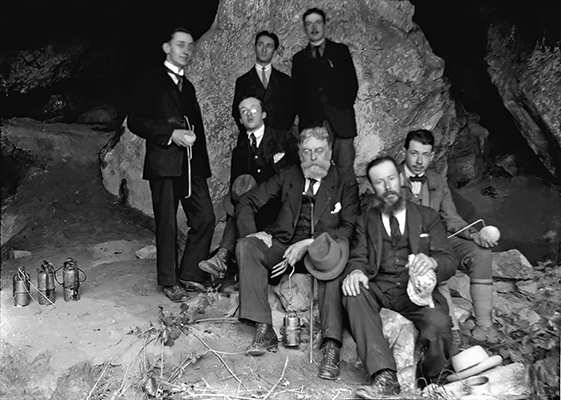
Entrance to the cave Marsoulas, campaign of excavations in 1931. Henri Bégouën centre, and on his left, holding the 'conch Marsoulas' J. Russell Townsend.
Locality : Marsoulas cave, Marsoulas, Haute-Garonne France.
Excavations in 1931 by Henri Bégouën (University of Toulouse), and J. Townsend Russell (Smithsonian Institution).
Catalog: Muséum of Toulouse MHNT.PRE.2010.0.1.2
Source: Muséum de Toulouse
Photo:Unknown.
Upload, stitch and restoration by Didier Descouens
Permission: This file is licensed under the Creative Commons Attribution-Share Alike 3.0 Unported license.
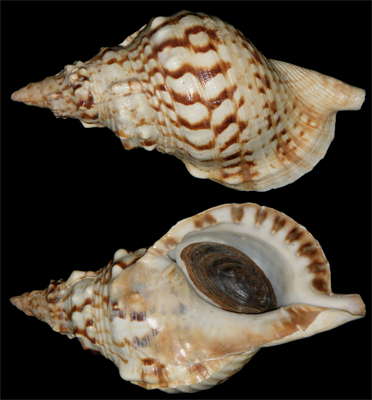
A modern Charonia lampas lampas form nodifera Lamarck, 1822, Morocco. 20 cm. acquired 1987.
Photo: MerlinCharon
Date: 28 January 2011
Permission: Public Domain
The fauna collected is sparse but normal: fox, reindeer, horse and aurochs.
The clearing of the entrance has necessarily increased the size of the opening. This has resulted in air penetrating more thoroughly and more deeply into the cave. The consequences were not long in making themselves felt. Visiting Marsoulas again in the warm days of last summer (1932) with M. l'abbé Breuil, we found that the condensation zone of atmospheric moisture extended until it stretched as far as the beautiful bison painted with red dots, which was previously out of reach. The walls were covered up to this point of the cave with small droplets of dew.
We know the damage that water containing carbonic acid causes to paintings and engravings in corroding walls, as at les Combarelles.
We immediately, as was our duty, advised the administration of Fine Arts should be covered by a low wall with a solid door, to stop this dangerous influx of outside air, and it is hoped that the Ministry will not delay in making the necessary arrangements.
If we insist on this point it is because we have unfortunately seen that prominent scholars, enjoying uncontested authority in anthropology, but unfamiliar with the cave, do not believe in the harmfulness of this condensate.
We hope now that the entrance is clear, we can continue to follow the program outlined and complete these searches, deep inside the cave, despite the difficulties of such a task, given the limited strength of the ceiling beyond the heap of pieces already collapsed. One once nearly crushed l'abbé Cau-Durban. But surveys have shown that previous excavators have not explored everything, and we hope to continue their discoveries.
References
- Bégouën Comte, Russell J., 1933: La Campagne de Fouilles de 1931 à Marsoulas, Tarté et RoquecourbèreMission Franco-Américaine de Recherches Préhistoriques, Toulouse Édouard Privat, Libraire Éditeur 14, Rue des Arts, 14, 1933
- Cartailhac É., 1902: Note sur les dessins préhistoriques de la grotte de Marsoulas, Comptes-rendus des séances de l'Académie des Inscriptions et Belles-Lettres, 46e année, N. 5, 1902. pp. 478 - 483.
- Fritz C., Willis M, Tosello G., 2016: Reconstructing Paleolithic cave art: The example of Marsoulas Cave (France), Journal of Archaeological Science, Reports (2016) 10: 910–916. doi:10.1016/j.jasrep.2016.05.012, http://dx.doi.org/10.1016/j.jasrep.2016.05.012
- Leroi-Gourhan A., 1973: Prähistorische Kunst: d. Ursprünge d. Kunst in Europa, Herder, 1973 - 601 pages
- Méroc L., 1948: La grotte de Marsoulas (Haute-Garonne), Publisher: Toulouse : Les Frères Douladoure, 1948.
Back to Don's Maps
 Back to Archaeological Sites
Back to Archaeological Sites
